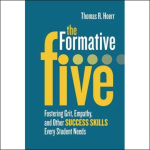Data Informed Instruction
Early Steps
There are a few key steps to effectively incorporating MBE (Mind, Brain & Education) ideas and concepts into one’s daily teaching routine. The first key is the low hanging fruit, namely, educating oneself on the research about learning and the brain and what the research suggests are effective pedagogies. If you are reading this blog, you are probably already familiar with one fantastic resource for such information (shameless plug warning!)) – www.learningandthebrain.com
There are certainly plenty of resources out there and I strongly encourage you to seek them out. This first step is critical and has become easier in the last few years as more and more of the actual research is available online and more and more has been written for teachers as the target audience.
The second key step involves actually trying something new in your classroom, whether it is using more retrieval practice exercises [1], incorporating movement [2] or perhaps shifting to a more student-centered model for class discussions [3].
Quantum Leaps
But wait, your work is not done! Trying something new based on the conclusions of a research paper you read is certainly a big step but how will you know that the change you made was effective? What is your evidence that the change you incorporated actually improved student learning? THIS is the difficult part.
Analyzing the impact or effect of a new pedagogy is quite complex and requires the collection and analysis of data. While you may not be able to perform a double-blind controlled experiment–the gold standard in scientific research–you CAN analyze the impact of your intervention and use data to inform your teaching practice going forward.
So how do you collect data that can help you improve your teaching practice?
I have found that one of the most useful tools for collecting data is one of the easiest to set up and use, but is frequently one of the least likely to be used by teachers – videotaping your class.
Watching a videotape of your class and objectively analyzing the tape for evidence of improved learning can be extremely enlightening, illuminating and humbling.
- Did I really only give Hermione 2 seconds of wait time before I moved on to Draco?
- Were the students really trying to take notes, listen to me deliver content and participate in the conversation simultaneously?
- Did I really shake my head in disapproval as Luke responded to my question with an answer that was way off base?
I have yet to find a teacher who enjoys watching himself/herself on video but have found that most teachers who actually go through with it find the experience to be incredibly informative. Watching your video with a trusted colleague or Critical Friends group can be even more thought provoking and lead to fruitful conversations about teaching and learning.
Data 2.0
I have been playing around with an exciting new tool for data collection lately that has the potential to make the time consuming analysis of videotape seem like a thing of the past. The app does a deep dive into an audio recording from class and provides me with nearly immediate data to analyze.
Here’s how it works: At the beginning of class I start an audio recording of the class on my phone and hit stop when the class is over. In the current iteration of the app, I upload the audio file to be analyzed and within an hour or so, I receive a report back on the class. Right now, the report includes data in 5 minute increments on:
- My talking speed (words per minute)
- How many questions I ask
- The types of questions I asked – How? vs Why? vs What?
- Percentage of the time that I was talking vs. the students were talking
Questions that I have been able to think more critically about with this data include:
- Was my student-centered class discussion really as student-centered as I thought?
- Am I asking questions that require surface level knowledge (“what”) or ones that will lead to more critical thinking on the part of my students (“why,” “how,” “if”)?
- Am I speaking too fast when giving instructions as I set up an activity?
The app is still in its development phase and there are bugs to be worked out before it will be available to a wider audience; but if you are interested in participating in the pilot, you can sign up here. Of all the data collection tools out there, I think that this app has the potential to be an incredibly valuable tool for teachers as they attempt to evaluate the impact of changes in their practice.
For all of its potential uses, I do realize that their are potential dangers with the collection of this type of data. Who initiates the collection of the data? What if an evaluator or administrator wants to use the data? What are the privacy concerns about collecting this type of data? Who has access to the files and data?
All of these questions are important ones that need to be fleshed out to be certain; however, I believe that if properly used, this app has the potential to be a powerful tool for teachers who want to use data to inform their teaching as they incorporate new strategies and pedagogies.
- http://www.retrievalpractice.org/
- Donna Wilson, Move your body, grow your brain, March 12, 2014 [link]
- Goldschmidt, M., Scharfenberg, F. J., & Bogner, F. X. (2016). Instructional efficiency of different discussion approaches in an outreach laboratory: Teacher-guided versus student-centered. The Journal of Educational Research, 109(1), 27-36. [link]





Thank you for these thoughts. Are there any updates on the app referred to in the article? Is it still being tested or is it widely available?
I checked with Scott MacClintic, and he tells me that delinity did not bring its product to market. However, you might check out the Earshot App [link], which offers similar features. If you try it out, let us know how you like it!